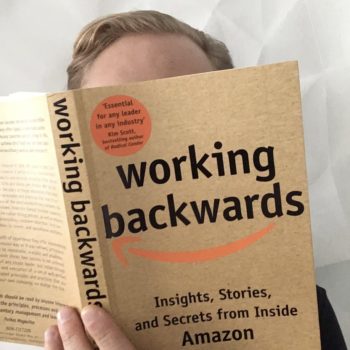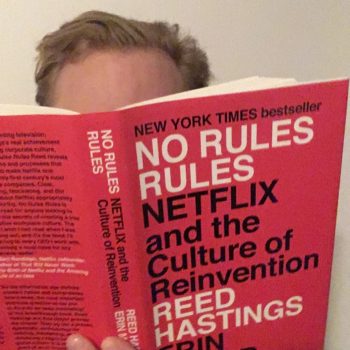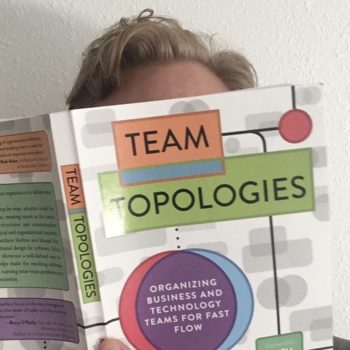
Working Backwards
Insights, Stories, and Secrets from Inside Amazon
Categories:
CTO,
Engineering Manager,
Product Manager,
Startup Founder
How strongly do I recommend Working Backwards?
8 / 10
Review of Working Backwards
Working Backwards is authored by two former Amazon executives that played critical leadership roles in the development of Kindle, Prime, Alexa, and AWS. The authors are definitely Amazonians to the core, but this book still reads like an in-depth explanation more than promotional material.
Working Backwards is to Amazon as How Google Works is to Google and I recommend reading both.
Top Ideas in This Book
- Innovation is driven by speed of execution and willingness to endure failure
- Don’t increase cross-team communications, eliminate them
- Single-threaded leaders increase probability of success
- Amazon banned presentations in favor of written narratives
- Focus on variances like YoY growth when presenting data, bypassing values that meet expectations
- You cannot successfully outsource custom, integrated, and end-to-end experiences
- Obsess over customers, pay attention to competitors
- Amazon’s core value proposition lies in the combination of price, selection, and convenience
- Promote strong general athletes into leadership roles
- Use equity to align employee incentives with long-term company success
Innovation is driven by speed of execution and willingness to endure failure
Innovation is constrained on the number of swings you can take and by executing faster we can take more swings. Faster moving teams innovate more than slow moving teams.
In addition to fast moving teams, Jeff Bezos says, “Most organizations embrace the idea of innovation, but are not willing to suffer the string of failed experiments necessary to get there.”
Don’t increase cross-team communications, eliminate them
Many companies observe communication gaps between teams, then commit to improving those communications in both frequency and quantity. Amazon takes the opposite approach by looking to eliminate cross-team dependencies and communications in order to increase the autonomy of teams.
Single-threaded leaders increase probability of success
Amazon is known for two-pizza teams but the authors write, “… we later came to realize that the biggest predictor of a team’s success was not whether it was small but whether it had a leader with the appropriate skills, authority, and experience to staff and manage a team whose sole focus was to get the job done.”
You want both leaders and teams focused on a single domain, limiting their cognitive load and increasing the probability of delivering customer value.
Amazon banned presentations in favor of written narratives
PowerPoint presentations are rife with hand-waving, style, and entertainment. Conversely, written narratives offer nowhere to hide, forcing authors to show their work and explain their analysis coherently and logically.
Written narratives at Amazon primarily come in two forms: six page memos and PR/FAQs.
Six page memos are used for meetings. At the beginning of each meeting, the meeting organizer delivers a memo up to six pages in length, which attendees read prior to discussion starting.
PR/FAQ docs are used to pitch product ideas, highlighting customer value, business value, and addressing anticipated questions.
Focus on variances like YoY growth when presenting data, bypassing values that meet expectations
When presenting data, most people cover all the data. Amazons focus their minds on variances to drive understanding and decision making. Notably, YoY growth rates are compared rather than simple YoY static numbers because growth tells a more complete and often different picture.
You cannot successfully outsource custom, integrated, and end-to-end experiences
When faced with build-or-buy decisions, companies often ask whether the problem fits into a core competency. If not, they outsource it.
The problem is that customers want highly integrated end-to-end experiences, not fragmented features, and outsourcing solutions limits your ability to meet customer demands.
Obsess over customers, pay attention to competitors
Amazon is famous for customer focus, but I appreciated this simple recommendation to obsess over customers and pay attention to competitors. Too many product teams inverse that relationship by obsessing over competitors and entering into a feature rat-race, paying little attention to what customers actually derive value from.
Amazon’s core value proposition lies in the combination of price, selection, and convenience
Amazon’s customers care about three things according to the authors:
- Price. Is the price low enough?
- Selection. Does Amazon have a wide range of products–ideally everything?
- Convenience. Is the product in stock, nad can I get it quickly? Can I easily find or discover the product?
I found it refreshing to boil down such a large and complex business like Amazon into a simple model like this.
Promote strong general athletes into leadership roles
With a solid foundation in business and technology, strong general athletes (SGA) at Amazon often changed divisions, becoming subject matter experts in multiple domains along the way. By porting these highly adaptable SGAs to different domains, Amazon can spin up new product areas while upholding leadership principles.
Use equity to align employee incentives with long-term company success
Amazon caps salary relatively low compared to other FAANG companies but offers more stock compensation in order to align everyday employees’ incentives with long-term company success.




